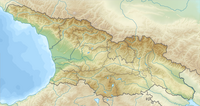 | ||
| no picture on Wikidata: | ||
| დმანისის ნაკალაკარი (Dmanisis Nakalakari) დმანისის მუზეუმ-ნაკრძალი (Dmanisi Museum-Reserve) | ||
| Region (Mchare) | Kwemo Kartli | |
|---|---|---|
| Residents | - | |
| no value for residents on Wikidata: | ||
| height | unknown | |
| no value for height on Wikidata: | ||
| Tourist info | 995 32 299 80 22 museum.ge | |
| no tourist info on Wikidata: | ||
| location | ||
| ||
Dmanisis Nakalakari (დმანისის ნაკალაკარი) or Dmanisi Museum-Reserve (დმანისის მუზეუმ-ნაკრძალი) is an archaeological site and museum complex in the region Kwemo Kartli, about 75 km southwest of Tbilisi. It is considered one of the most important attractions in the country. The site became famous v.A. because of the hominine fossils found from 1991 onwards, which revolutionized anthropology.
background
The Dmanissi Plateau has been the site of thousands of animal fossils for a long time, some of which are key fossils for the "Upper Villanium" in Central Europe (2.5 to 1.3 million years old). Since 1991, over 50 body skeleton parts and stone artefacts have been discovered on the plateau on an area of 150 square meters, which can be dated to an age of 1.75 million years. In 2001, scientists found the skull of a 1.8 million year old early man. This is the oldest secured find of the genus Homo outside of the African continent. The scientific discussion on the anthropological classification has not yet been concluded.
The historical city of Dmanissi was located in the immediate vicinity of the archaeological sites. It was laid out and fortified in the 5th century at the latest. The ruins of the city, within which settlement relics from the Bronze Age were discovered, are also presented as museums. Right next door is the Sioni Church of Dmanissi, which is also located in the core on the 5th-6th. Century can be dated.
The town Dmanissi, Capital of the municipality of the same name, is about 15 km east of the excavation and ruin site. The Azeri settlement of Bashkitscheti was named Dmanissi in 1947 in honor of the historic city. When they speak of "Dmanissi", tour operators never mean the city but always the excavations or the museum. There is hardly anything to see in the city itself.
getting there
Public transport: With minibuses (marshrutkas) along the route Tbilisi-Marneuli-Bolnissi-Armenia get off at Patara Dmanissi (ask the driver to stop). Departure from Tbilisi from Ortachala.
Automobile: From the E117 / ს 6 turn off at Patara Dmanissi. The short feeder road is well signposted.
mobility
The museum area is equipped with steep gradients and some arduous cross-country passages. The area is not suitable for wheelchairs.
The museum grounds
The museum area includes the following sights:
Dmanisis Sioni Church

2 Dmanisis Sioni
Church in the core from the 6th century, with extensions and gate from the 12th century, one of the most important sacred monuments in the country.
Dmanisis Nakalakari

3 Dmanisis Nakalakari
Medieval castle and settlement complex, now in ruins, with an old bath house, fortification towers and walls. The complex from the 5th century still includes a settlement from the Bronze Age inside. Great view from the high plateau.
Archaeological excavations
.jpg/220px-Dmanisi_site._Bronze_Age_burial_(Photo_Sofia_Jojua).jpg)
4 Archaeological excavations
The sites of the hominid fossils are partially accessible and prepared for visitors. So you can visit old tombs, etc.
miscellaneous

There are also numerous pre-Christian animal figures carved into the rock on the site.
activities
- Paleoanthropological field courses: Anyone interested can attend a course in the field of palaeoanthropology on site in the field for one month each summer. The course fee of 3000 Lari also includes study materials, room and board. Interested parties write an e-mail with a goodwill to [email protected], after which ten candidates for the course will be selected by a committee. Attending the course is worth 8 ETCS points.
shop
There is a small souvenir stand on site. Markets and shops can be found in the neighboring villages; especially in Dmanissi, Kasreti and Bolnissi.
Kitchen and accommodation
There are no restaurants or accommodations in the vicinity of the historic site. The next hotel is in Bolnissi.
nightlife
Safety and health
- The footpaths in the area of the ruined city are neither secured nor particularly well developed. Risk of falling and falling off the cliffs!
- Because of the strong sunlight, you should not only have a hat and sunscreen with you in midsummer.
Practical advice
Decent clothing is essential for visiting the church: knees and shoulders covered, women with a headscarf and skirt (or a scarf that is placed around the hips).
trips
literature
Web links
- Hominin fossils from Dmanissi on Wikipedia
- Dmanisi Museum-Reserve website
- Information about the excavations: http://www.dmanisi.ge

